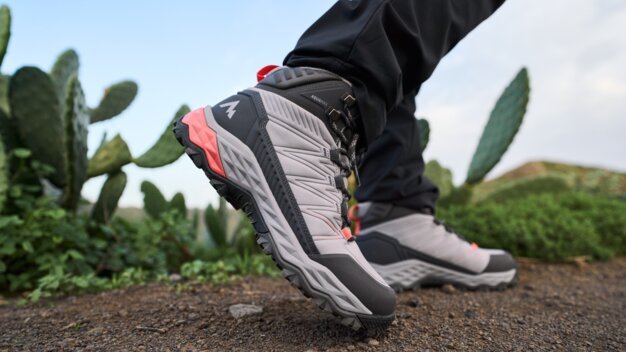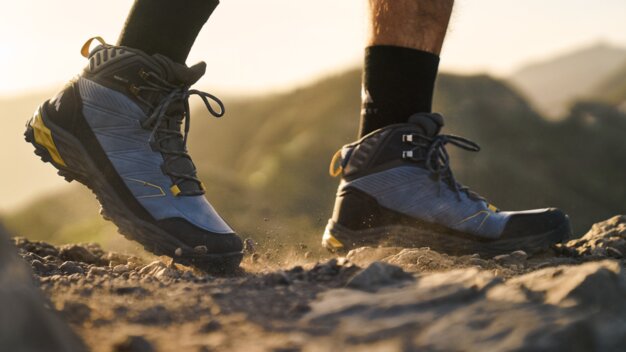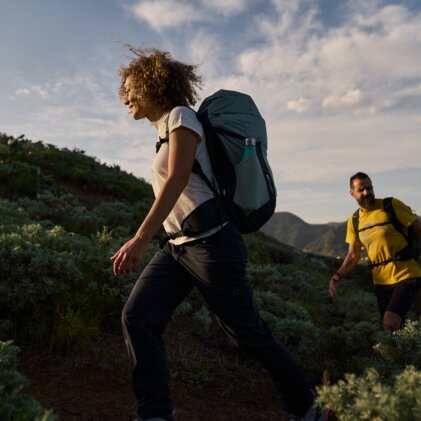
If it's your first time in the shop, you may feel overwhelmed by the selection of hiking boots. How can you recognise a good hiking shoe and what categories are there?
Our RENTertainers have addressed this question and present the most important categories to you. In doing so, we go into the features and also specify their areas of use. If you need help choosing your future hiking shoes, our experts are always available for advice at over 800 locations.
What makes a good hiking boot?
When looking for the best hiking boot, there are several criteria by which it can be assessed and which ultimately determine its area of use. We have listed a few for you:
Shaft height
Hiking boots with a high shaft enclose the ankle, providing extra support and stability. This provides effective protection against twisting your ankle, which is particularly important on steep, stony or uneven paths and on longer tours with a heavy backpack. A high shaft also keeps dirt, stones, snow and moisture out better and reduces the risk of injury. In contrast, low hiking boots are lighter and allow more flexibility in the ankle.
Sole profile
Hiking boots with a deep, coarse profile offer good grip on soft, muddy or uneven ground. The pronounced studs dig deep into the ground and ensure a secure grip - ideal for demanding mountain tours, hikes in wet conditions or on scree fields. Shoes with a flatter profile are lighter and more comfortable to wear on daytrips.
Sole stiffness
Outdoor shoes with a stiff sole offer great stability and protect the sole of the foot from sharp stones, roots or uneven terrain. They reduce flexing of the shoe and provide a secure grip, especially on long tours with heavy luggage or on alpine paths. This is also essential when climbing on ledges or when using crampons. A soft sole, on the other hand, supports the natural rolling movement of the foot and is more comfortable on easy hikes.
Sole cushioning
Sole cushioning plays a central role in hiking. Highly cushioned shoes absorb shocks effectively and relieve the strain on joints, ligaments and your back. This makes them ideal for long day hikes, trekking tours with a heavy backpack or hikers who are travelling on hard, stony surfaces. Good cushioning also offers noticeable comfort for beginners and people with sensitive joints. But even low cushioning has advantages: it enables direct contact with the ground, which increases surefootedness.
Outer material for hiking boots
The choice of outer material determines durability, protection from the elements and breathability. Whether leather, synthetic or a mix of materials - each material has its own advantages and is suitable for different purposes. Hiking boots made from leather are highly durable and adapt naturally to the foot. The material is also very durable and offers solid protection against external influences, which is why outdoor shoes made of leather are preferred for longer tours or changeable weather conditions.
Synthetic materials such as mesh or synthetic fibres impress with their low weight and high breathability. They dry quickly and are easy to care for - ideal for day hikes, warm temperatures or when the load to be shouldered plays a major role. There are also hiking boots that combine synthetic fibres and leather to create a material mix that provides the best of both worlds.
Good hiking shoes at a glance
If you want to find some good hiking shoes, you should think in advance about what your future tours will look like. Someone planning a high-altitude tour will have different requirements for a shoe than someone hiking along forest paths to the nearest mountain hut on holiday. Let's take a look at the categories:
Light hiking shoes
At first glance, lightweight hiking boots have little to do with the shoes that many people imagine. They are more reminiscent of sporty everyday shoes and are designed for walks and easy paths on flat terrain. It should be noted that the category of lightweight hiking boots also includes approach shoes, which sometimes have a much firmer sole and abrasion-resistant materials.
Features:
- Short upper and cuff guarantees freedom of movement
- Less cushioned sole (the cushioning is designed for easy hikes and the additional weight of a daypack).
- Low sole stiffness
High-cut hiking boots
These high-cut hiking boots look most like mountain hiking boots. There are many models among them that are suitable for beginners who are mainly travelling on paved paths in low mountain ranges and the foothills of the Alps.
Features:
- High cuff for more stability
- Cushioned midsole to absorb light impacts and shoulder the weight of a backpack on day hikes
- Stiffer sole
"Classic" trekking shoes for hiking
Anyone looking for classic trekking shoes wants to tackle extended day tours and easy hikes in alpine terrain. Here, the ground may well be rocky and the ascents steep.
Features:
- An even stiffer sole like the high-cut hiking boots
- Deep treads
- High cuff
- Well-cushioned midsole to distribute the pressure from stony ground more effectively in easy alpine terrain.
Heavy hiking shoe
With a shoe in this category, ambitious trekking tours up to alpine terrain are possible. In addition, the surroundings are often stony and rough. Trekking boots are the preferred choice up to an altitude of 3,500 metres.
Features:
- Cushioned midsole for multi-day tours
- Sole with deep tread for rough terrain
- High shaft for sufficient stability in alpine terrain
- Stiff sole for medium-sized ledges on alpine tours
Mountain boot/altitude mountain shoe
In contrast to the previous categories, the high-altitude mountain boot is much more robust. The sole is also so torsion-resistant that small protrusions in the rock can be used to push yourself up, making them ideal for alpine tours on stony ground. As the name suggests, they are ideal for multi-day excursions in cold conditions.
Features:
- Mountain boots are considered suitable for crampons
- Very stiff sole
- High shaft with high lacing
- Especially warm for tours at high altitudes
- Very robust materials
Expedition boots
This is a category of hiking shoes that allows you to tackle tours over 5,000 metres. Their soles are so stiff that it doesn't matter whether there is a path or not. If you are looking for a boot for the highest mountains in the world, you will find the right model among the expedition boots.
Features:
- Are fully suitable for crampons
- Depending on the model, with removable inner shoe for extreme cold
- Very stiff sole for tours without obvious paths
- Very deep tread for sufficient grip on any surface
- Extremely robust upper materials
What you should look out for when choosing a good hiking shoe size
Once you have found a category that you feel comfortable with and that suits your tours, you should make sure you get the right size. Make sure you wear the right hiking socks when you try them on. These are usually thicker than normal sneaker socks, are made of breathable material and have pads to prevent pressure points. With the right socks, you can get a feel for the right size in the shop.
Also bear in mind that water can accumulate in your legs and feet on long hikes. For this reason, many hikers tend to wear shoes that are a little larger to avoid space problems.
If you're struggling to choose the right size, our RENTertainers will be delighted to hear from you. Our experts are happy to assist you with their knowledge at our more than 800 locations.
Frequently asked questions about good hiking shoes
How much should good hiking boots cost?
The cost of hiking shoes depends heavily on their category, the features, the materials used and your own requirements. Simple hiking boots can cost between €60 and €90, while specialised models for alpine tours usually start at €150.
Are high- or low-cut hiking boots better?
Both designs have their advantages and disadvantages. While low-cut hiking boots offer more flexibility in the ankle, the stability of hiking boots with a high shaft is better.
Is a hard or soft sole better for hiking boots?
A hard sole is particularly advantageous on alpine climbs and unpaved paths when you need to find a foothold on small ledges to make progress. A soft sole, on the other hand, is good for easy paths when comfort is the priority.
INTERSPORT Rent Tip
The RENTertainer recommends
If you are looking for good hiking shoes, you should think about which tours you are planning in advance. The clearer your picture of future tours is, the better our RENTertainers can advise you. It can therefore be very helpful for the experts in the INTERSPORT Rent shops if you tell them about the altitude, the terrain and the length of your planned routes.
If, on the other hand, you find it difficult to formulate this for yourself or are even caught between two neighbouring categories, we can help you on site at one of our INTERSPORT locations.
Related articles
You may also be interested in:





